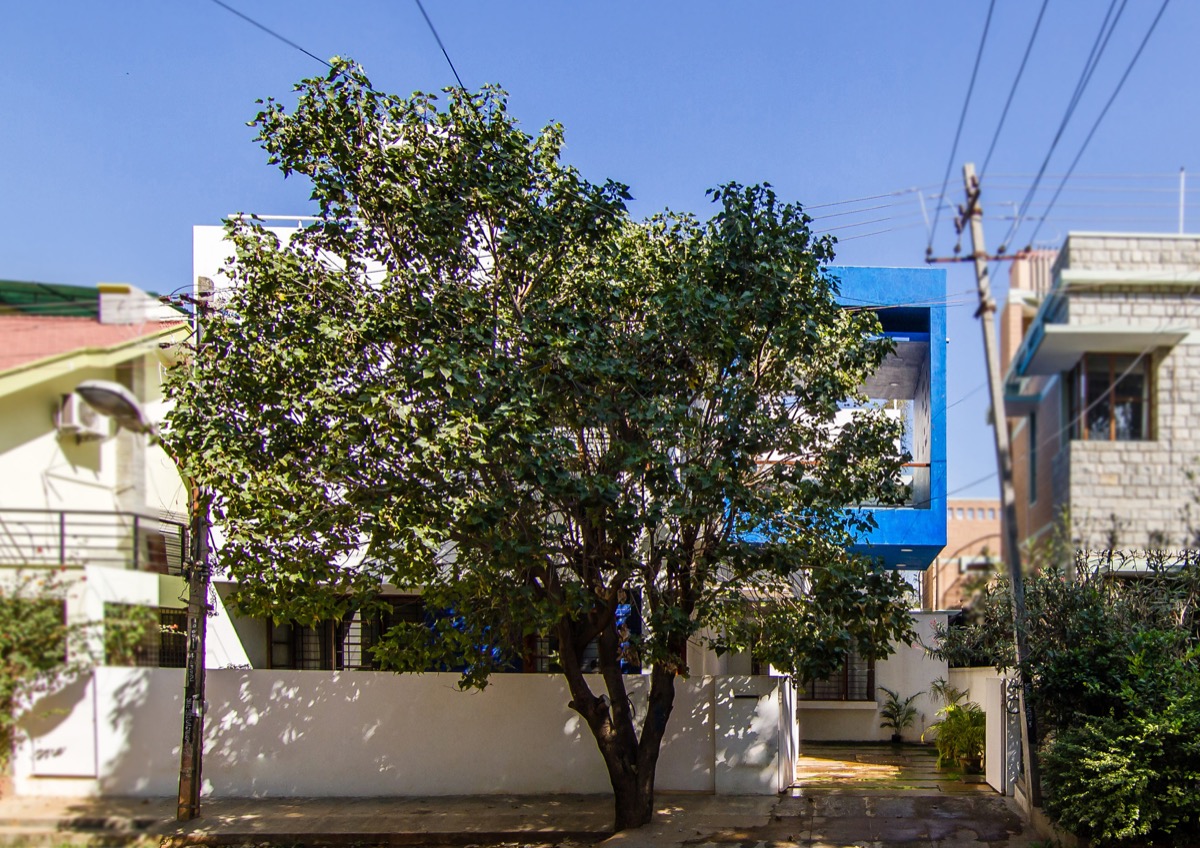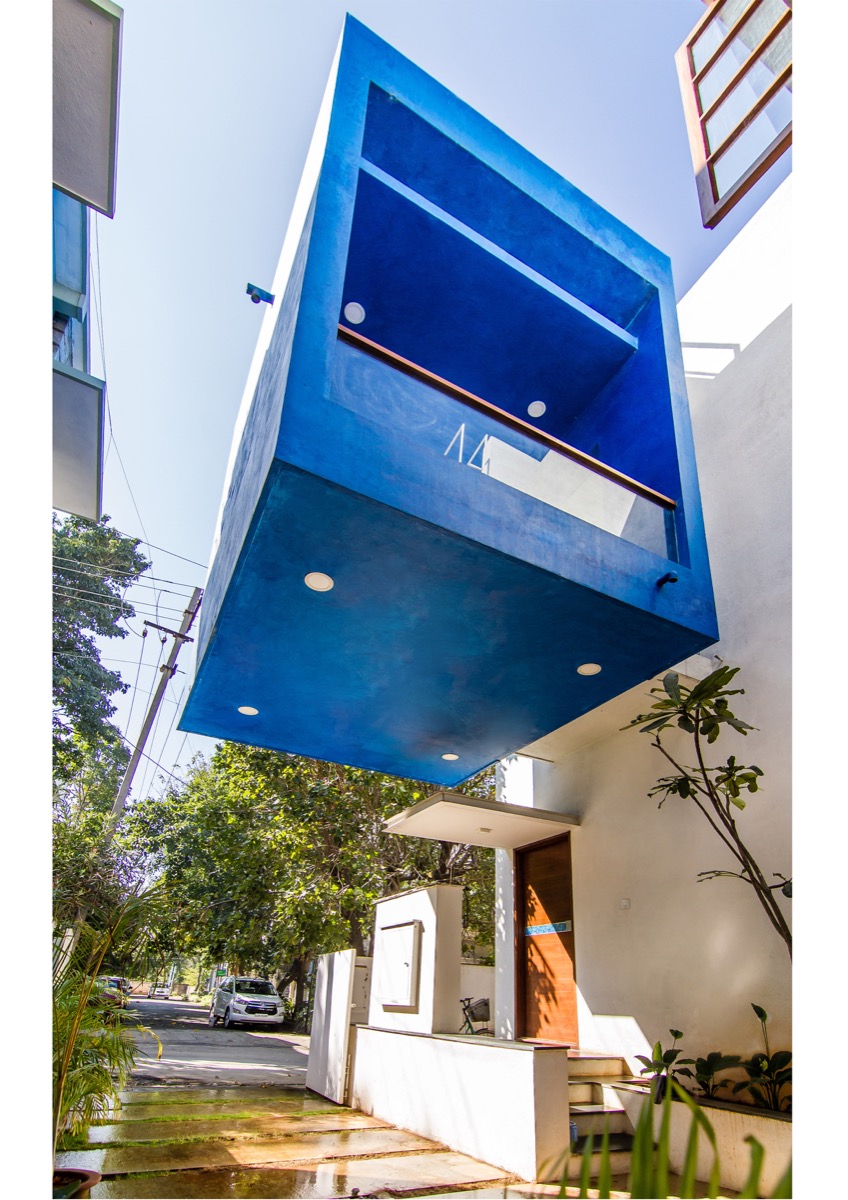 Prasanna House is an illustrative, where an urban context has been transformed into an intimate and tranquil living space. Trees, leaves, and nature are the essence of the project, bringing it to life.
Prasanna House is an illustrative, where an urban context has been transformed into an intimate and tranquil living space. Trees, leaves, and nature are the essence of the project, bringing it to life.
CLIENT’S BRIEF
The clients being simple and deep rooted were looking to have a home that resonated tranquility and was an escape from the hustle and bustle of the city life. The house needed to be well ventilated with ample day light throughout the day.
ABOUT THE SITE
The proposed site located at a T-junction of a prime residential area that faced an agricultural institute just a stone throws away. The design was hence conceptualised on capturing and framing this view. Establishing visual connectivity, an opening was created on the front facade- THE FLOATING CUBE.
CONCEPT
The main idea was to merge the built within the landscape. As the building ages and the trees grow, the built-and unbuilt will become more and more seamless. The design responds primarily to the context by retaining an existing tree and brings its essence within. Nature has been brought within the house by carving out green spaces throughout. A central courtyard functions as a transition from a public space to a private one. The court is kept as a focus by the allure of black granite. The court is floored by the flowers of Frangipani.
THE FLOATING CUBE
Framing the vista ahead the balcony appears to float right above the entrance, deliberately done to achieve a column free parking area below. This area could occasionally turn into a gathering space which the clients had expressed a need for early on, in their requirements. Punctures were added to create interest within the space.
INTERWEAVING SPACES
The spaces are created to be more dynamic. As one enters the house, they can see an uninterrupted line of vision with green pockets in between. The living opens to a green court which is rather rejuvenating.The central court extends to become the Puja space of the house. The dining unfolds beyond, translating into a rear court, hence blurring the interior and exterior boundaries.
The bedroom on the ground floor merges with the landscape. A huge skylight and a landscaped floor are integrated into the bathroom, to create a sense of outdoor bathing.
A cooling, exposed concrete staircase aids us into the family area of the house. The family space is designed to be warm with its wooden flooring and minimal decor. A cantilevered bedroom overlooks the courtyard from the level above. A cantilevered balcony projects out of the master bedroom in order to celebrate the surrounding view.
Every space is visually connected to enhance interaction within the house. A level difference is tactfully used to mark the various spaces in place of creating walls, and yet the privacy of each space is well maintained.
The louvered shutters delightfully transform the function of the bedroom. While closed, it maintains the privacy of the space and when opened facilitates a seamless visual connection between different spaces. Standing at the louvered opening of the master bedroom one can look onto the Family space. This line of vision infinitely continues beyond the space through a slit of glass that subtly leads the eye towards the sky.
POETICS OF LIGHT
A thoughtful design is one where you understand the language of the materials around. The blank wall stood there like a canvas, waiting for the artist to transform it into a masterpiece. A skylight covered by an array of colorful leaves was introduced into the space. The pattern it casts on the wall, constantly changes with time and term. The colours of the leaves and its artistic patterns on the background completes the frame.
ARTISTIC MATERIAL PALETTE
The material palette is kept minimal, marble flooring captures reflections while exposed concrete ceilings add a rustic charm. Wooden flooring and details bring in richness with the white walls tying it all together.To add a little color, the projected cube in the front is painted blue with random punctures.
Drawings:
Project Facts:
Client : Mr. & MRS. PRASANNA
Type : Private residence
Location : Bengaluru
Site area : 2006 sft
Built up area : 2800 sft
Year of
completion : 2015
Project cost : INR 80 lakhs
Project team : Swapnil Valvatkar, Balakrishnan
Firm : Collage Architecture Studio | collagestudio.co.in
Location : Bangalore





























